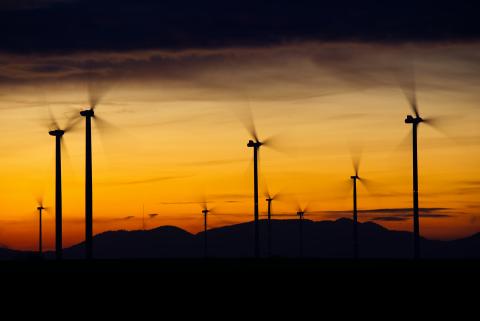IEEFA: NSW sets out a clear path to sustainably lower cost electricity

Key Findings
The NSW Electricity Infrastructure Roadmap sees a $32bn regional investment plan by 2030
The appetite of global investors for low-risk, long-dated power purchase agreements in renewable energy infrastructure is unprecedented.
While it would be easier if Australia had a national electricity plan, NSW can’t afford to wait another decade for this to occur.
The last two months have been a defining point on actions for the Paris Agreement. Following on from China, both Japan and South Korea have pledged net zero emissions by 2050 targets. And President-elect Joe Biden has promised to make climate change a top priority for the U.S. again. The implications are clear, with BlackRock’s chair Larry Fink describing the “tsunami of change in asset reallocation right now” due to climate risk.
THE INVESTMENT OPPORTUNITIES ARE HUGE. Andrew Forrest’s Fortescue Future Industries has talked of a 235 gigawatt (GW) opportunity to its shareholders this month, a rather ambitious investment plan that would cost in the order of $235bn. Then there is the more measured 26GW, $38bn renewables and green ammonia Asian Renewable Energy Hub in the Pilbara, awarded ‘major project status’ last month by our Federal Government. The 10GW Sun Cable solar farm and subsea cable project linking up Darwin to Singapore is costed at $20bn.
The NSW Electricity Infrastructure Roadmap sees a $32bn regional investment plan by 2030
And the NSW Electricity Infrastructure Roadmap unveiled this month and passed by both NSW Houses of Parliament this week with bi-partisan support sees a $32bn regional investment plan by 2030. So when we talk of a $200bn investment opportunity, this could prove to be a very conservative estimate.
With all of Australia’s global major fossil fuel export destinations now committed to decarbonisation, the $100bn of fossil fuel exports Australia booked in 2019 will go down in history as the peak, with the Office of the Chief Economist estimating just $70bn in 2020/21.
IEEFA HAS LONG ARGUED THIS TECHNOLOGY DISRUPTION OF GLOBAL MARKETS IS INEVITABLE – a trend that is now accelerating and proving to be highly deflationary. Even the International Energy Agency finally declared solar the new king this year.
The NSW Electricity Infrastructure Roadmap aims to develop at least three renewable energy zones to facilitate the orderly and planned construction of 12GW of low-cost renewable energy, supported by 2GW of new storage capacity by 2030, along with the pre-requisite enabling investment in grid transmission capacity with a bespoke access-to-grid rule. This will reassure global investors that the marginal loss factor (MLF) unmitigated debacle can be circumvented by careful planning and investment.
Investor appetite for low-risk, long-dated renewable energy infrastructure PPAs is unprecedented
The appetite of global investors for low-risk, long-dated power purchase agreements in renewable energy infrastructure is unprecedented. And Australian interest rates are at multi-decade lows as the same global investors managing tens of trillions of dollars search for safe investment havens in low sovereign risk countries with strong governance, low currency risk, land available at scale, plus excellent wind and solar resources.
But a mutually reinforcing triumvirate is needed for this plan to deliver lower cost, reliable and low emissions electricity for NSW consumers. Low cost but intermittent renewable energy must be built ahead of the unpredictable progressive closure of NSW’s aging and expensive coal-fired power fleet. Investors will only fund low-cost infrastructure projects if the enabling grid investment is made. And grid-reliability can only be assured by a significant step-up in investment in flexible peaking power capacity, including storage.
IEEFA has argued that COVID-19 has reinforced the importance of Australian self-reliance and onshoring of manufacturing. Global commitments to net zero emissions by firms like Rio Tinto are clear. But without a path to sustainably lower the cost of, and decarbonise Australian electricity, the threat to tens of thousands of existing high-paying Australian jobs is a clear and present danger (think closure of New Zealand’s Tiwai Point). Rio Tinto’s Australian aluminium refineries are the highest emission units in the world. They are aging, and underperforming.
THE NSW ELECTRICITY INFRASTRUCTURE ROADMAP OFFERS A CLEAR AND VIABLE PATH out of the energy policy wars of the last decade. Aurora Energy and KPMG modelling offers trade-exposed industry a path to average bundled wholesale electricity prices as low as A$40/MWh. This is in the lowest decile of industrial prices in the world. Tomago in Newcastle is some 10% of NSW’s total electricity demand, and aluminium is little more than alumina and solidified electricity.
NSW can’t afford to wait another decade for a national electricity plan
While it would be easier if Australia had a national electricity plan, NSW can’t afford to wait another decade for this to occur. Nor can Tomago, whose subsidised electricity contract expires in 2028. Delivering infrastructure takes planning and time. Absent a Federal plan of substance aligned with the global reality of 2020, NSW’s government has elected to lead.
The NSW Electricity Infrastructure Roadmap is exceptionally well thought through. It is predicated on delivering sustainably lower cost delivered electricity to NSW consumers, and likely with improved reliability. Crucially the plan addresses global investors’ need for long-term clarity and sufficient revenue certainty to drive down the cost of capital and hence delivered cost to consumers.
In several areas the plan is very conservative and the cost reduction benefits to NSW consumers could well prove substantially higher than modelled. For example, the capital cost of investment and cost of capital assumptions are too high, and the plan assumes other states benefit from NSW investments. More likely, other states will also replicate their own versions of this plan in this technology race so that all Australians benefit.
The employment, export and investment opportunities are huge. Consumers will benefit. Downstream industry will be rejuvenated after a decade of fossil fuel-driven energy cost inflation. And Australia will move from global climate laggard to our place at the forefront of the energy transition, embracing change and all the opportunities this will bring.











